Punjab State Board PSEB 10th Class Physical Education Book Solutions Hockey Game Rules.
Hockey Game Rules – PSEB 10th Class Physical Education
Question 1.
How many players take part in the game of Hockey?
Answer:
Players:
1. The game of hockey is played between two teams. Each team consists of 11 players. During the play no team will have more than one goalkeeper.
2. During the play a team can substitute maximum number of players.
3. A player once substituted can play again. No player can play in place of a suspended player.
4. No substitute is allowed during the award of Comer, Penalty Comer and Penalty Stroke. During the stoppage of play, except for the award of a comer, a penalty comer, or a penalty stroke, the substitute player can enter the playground with the permission of a referee. Time taken by it will be added to the duration of the game.
5. If extra time is given to draw some result the other player can also be substituted.
![]()
Duration of Play
The game has two durations of 35 minutes each. There is an interval of minimum 5 minutes to maximum 10 minutes in between the two durations. The teams change their ends/sides after the interval.
Captain
(a) In the beginning captains of both teams toss for the choice of ends or doing pass. The winner of the toss can choose one of the two pass or end.
(b) A captain may act as umpire in case of his absence.
(c) If necessary, the captains can change their goal keepers, and will inform about the change to the umpire.
Question 2.
What do you mean by the following? The field of Play, Goal post, Goal Board, Shooting Circle, Ball Hockey (stick), Dress of Players and Back pass.
Answer:
Field of Play:
The hockey playground is rectangular in size. It is 100 yards (91.4 m) long and 60 yards (55 m) wide. The longer lines are known as side lines and shorter lines as goal lines. The goal line shall be 3 wide. There is a Centre line in the middle of the playground which divides the ground into two equal parts. In between the goal line and centre line there is a 25 yard line, and parallel to five yards from a side line a mark two yards in length will be provided.
Inside the playfield, on each side line and parallel to the goal line 16 yards from its inner edge a mark 12 in length will be provided. For hits of corners, the field shall be marked by the goal lines on both sides of the goal at 5 yards. At a distance of 7 yards in front goal lines on both sides of the goal at 5 yards. At a distance of 7 yards in front of the centre of each goal a spot shall be marked which will not exceed 6 in diameter.
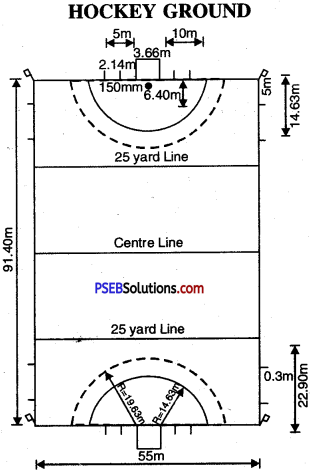
Hockey Field
Goal Post:
At the centre of each goal line, there will be a goal post consisting of two perpendicular posts 4 yards apart. These are joined together by a horizontal cross bar, 7 feet from the ground. The first part of the goal post will touch the outer edge of the goal line. Goal post shall not extend the cross bars, and cross bars, too, shall not extend goal posts. The goal posts and cross bars shall be 2′ wide and their depth shall not exceed 3′. The nets will firmly attached behind the goal posts. Their edges will be rectangular and they will face the playfield. The nets will be firmly attached behind goal posts, cross bars and goals, and the distance between these shall not exceed 6 inches.
GOAL POSTS
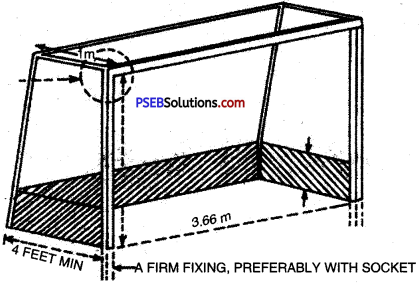
Goal Board:
Goal boards should not exceed 4 yards in length and 8′ in height. These will be placed on the comers inside the goal posts. These boards shall be perpendicular to the goal lines. Inside the goal posts the side boards will be placed in such a way that they have no effect on the inside of the goal or the outer width.
Shooting Circle:
A four yard long and 3 inch wide line shall be drawn in front of each goal. This line having the inner front corner of the goal posts as centre will reach each way to meet the goal lines by quarter circles. The space enclosed by these line, shall be called the shooting circle.
Ball:
The ball shall be made of white leather or of any other leather painted white. Its size is similar to that of the cricket ball, and it is sewn like the cricket ball, its weight should not exceed 5\(\frac{3}{4}\) ounces to 5 \(\frac{1}{2}\) ounces.
Its circumference shall be maximum 9\(\frac{1}{2}\)” and minimum 8\(\frac{3}{16}\)“.
Stick:
A stick should be flat on the left side alone. Its end should not be made of metal or attached with any metal. Its size is like the English letter “J”. It should not have any sharp edge on the top, neither should it have a dangerous splinter. Its weight shall be maximum 28 ounces and minimum 20 ounces. Its size is such that it may pass through a ring having a diameter of 2 inches. If the stick does not conform to these rules, it Will not be permitted to be used by the umpire.
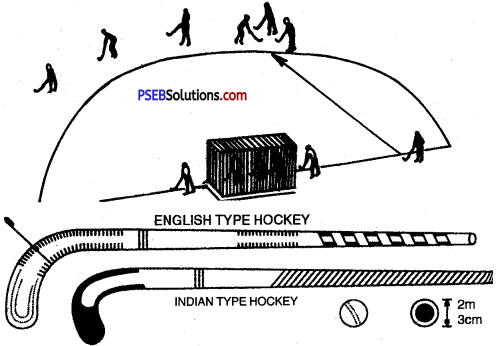
Players Dress and Equipment:
Each team wears the dress approved by its association. The dress is such that players of one team can easily be distinguished from the players of the other team. A player’s dress and equipment consists of a shirt, underpants, socks and a pair of shoes. Each player shall put on such foot-wear as are not harmful to any other player. The teams have to wear dresses of different colours.
SHOOTING CIRCLE
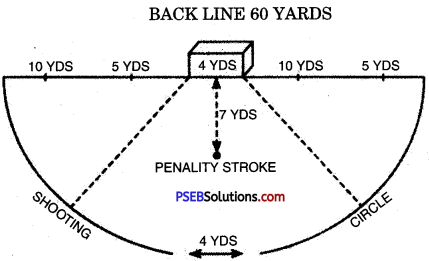
The goal keeper’s equipment includes pads, nickers, gloves and mask. The player should not wear such articles as a watch, ring or iron bangle (“Karra”) because they may hint other players.
Back Pass:
The back pass is given by the toss winning player at the start of the play after a goal has been scored, and to start the game after the interval. After half time the player of the opponent team will do back pass. The player doing pass may put his foot on the centre line or on the other side.
![]()
Question 3.
What are the General rules of hockey?
Answer:
GENERAL RULES OF HOCKEY
1. When a player hits the ball, no part of the stick should go above the shoulder.
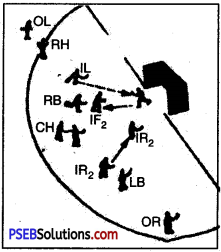
2. The ball should not be played with the opposite side of the stick. Only the flat side of the stick should be used. No player can interfere with the game without having his own stick.
3. The ball is not under cut. The game is also not played in such a way as it may give rise to a danger or make the play itself dangerous.
4. The ball should not be stopped on the ground or in air with any part of the body except the hand. If the ball is caught at all, it should be thrown on the ground quickly from the level of the chest.
5. Except with the stick, the ball should not be stopped, picked, thrown or carried in any other manner.
6. Hitting, hooking, holding, striking at or intervening with the opponent’s stick is not allowed.
7. A player should not obstruct the game by running between an opponent and the ball or intercept himself or with his stick as an obstacle. The attack should not be made on the left side of the rival. The ball should be touched before touching of the ball by the rival.
8. The goalkeeper is allowed to stop the ball with any part of his body in the shooting circle.
9. If the ball is lodged in the pads of a goalkeeper or in the clothing of any player or the umpire, the game will be stopped by the umpire. The game shall restart by a bully on the spot where the incident occurred.
10. If the ball strikes the umpire, the game shall continue.
11. No player is allowed to play in a dangerous manner or in the spirit of revenge. If a player misbehaves, the umpire can give him warning.
12. If it rains or there is a defect in the lighting system during the play of the match, the match will be resumed the next day.
13. Golden Goal Rule:
If the match ends in a draw, the extra time for play will be given, of which the durations of the play minutes each. Whenever during this period a goal is scored by a team the match ends there and then. In case there is no result, then 5-5 penalty strokes are given to each team till the winner is decided.
Breach of the Simple Rules of the Game
1. If infringement takes place outside the shooting circle, a free hit is awarded to the opposing team. But if the umpire thinks that the player of the defending team has committed the offence deliberately within 25 yards, then he must award the penalty comer.
2. If the offence is done inside the circle by an attacker, a free hit is awarded to the defending team. On the other hand, if the offence is committed inside the circle by the defending player, the attacker team is awarded a penalty corner or penalty stroke.
3. If two opponents commit the offence at the same time outside the circle, the umpire shall order for a bully to be played. But the bully should be played 5 yards off the goal line.
4. In case of rough play or misconduct, the umpire can:
- warn the offending player,
- suspend him temporarily, or
- suspend him from playing the game further
A player temporarily suspended shall remain standing behind the net of his goal until the umpire calls him back. The time for temporary suspension will not be less than 5 minutes.
![]()
Question 4.
What do you know about the Pass, Hit, Free Hit, Comer, Penalty Comer, Goal, Shooting Circle, Penalty, Umpire, Push in, Ball outside the play field, The use of “2” Iron Bangle (KARA).
Answer:
1. Pass:
The play starts when a player gives a pass to the other player by striking the ball on the centre line.
2. Hit:
If a player makes the ball cross the side line completely, he or any other player of the opposing team is allowed to hit the ball by placing it on the spot from where it has crossed the line.
3. Free Hit:
(a) Free hit is normally taken from the place of offence. A free hit shall be taken from the breach place provided that a free hit is given to the defending team within 16 yards of the inner edge of its goal-line.
(b) Scoop- stroke is not allowed in that case.
(c) While taking free hit, the ball shall remain stationary. The free hit shall be taken again in case any other player of any team is within 5 yards of it.
(d) If the striker fails to hit the ball, he can re-take the hit.
(e) The striker after taking free hit shall not play the ball until it has been touched or played by another player of either team.
4. Corner:
(a) The attacking team shall be awarded a penalty comer if in the opinion of the umpire, the defending team has sent the ball intentionally within 25 yards of the line, provided a goal is not scored. The player of the attacking team will take free hit on the goal line or side line of the defending team or on that spot from where the ball has crossed the line and which is 3 yards from the nearest comer flag post.
(b) When the hit is taken, other than six players of the defending team shall remain outside the playfield and their feet and sticks shall remain behind their goal line. The remaining defenders shall remain away from the centre until the hit is taken. The attacking team will be in the playfield. The feet and sticks of its players shall be outside the circle. If any player enters the circle before the ball is hit, the hit shall be taken again.
(c) No shot at goal shall be scored with the comer hit till any player of the defending team stops the ball on the ground or the ball is touched by his foot or any other part of his body.
(d) The umpire shall order for the hit again in case any player of the defending team crosses the goal or centre line or any player of the attacking team comes forward on his own before the hit is taken.
5. Penalty Corner:
If in the opinion of the umpire a player of the defending team has sent the ball off the goal line intentionally, he shall award a penalty comer to the opposing team provided no goal is scored. While taking a penalty corner, a player will do the ball push from a point inside the circle on the goal line, then the player standing on the edge of D will stop it with hockey, and the third player will hit it. The penalty comer shall be considered as goal if the ball does not go higher than the plank of the goal or there is no under cut, and the ball crosses the goal line.
6. Goal:
When a ball passing completely through goal posts has crossed the goal line, a goal is scored. At that time the ball should be within the circle, having been hit by the stick of an attacker. The team that scores greater number of goals is the winner. If the goalkeeper plays a foul at the time of penalty stroke it is not necessary for the ball to cross the goal line.
7. Shooting Circle:
A four yards long and three inches wide line shall be drawn in front of each goal which is parallel to and 16 yards from the goal line. This line having the inner front comer of the goal posts as centre will reach each way to meet the goal lines by quarter circles. The 16 yards distance shall be upto the outer comers of the circle and the face of the goal post.
8. Penalty:
If as a result of penalty stroke:
(a) The ball completely crosses the goal line between the goal¬posts and under the cross-bars, a goal is scored.
(b) The goalkeeper commits any breach and hinders the score, it is considered a scored goal.
(c) The goalkeeper catches the ball or the ball is lodged in his pad it is called ‘stopped’.
(d) A penalty stroke ends if the ball becomes stationary in the circle or passes over it.
(e) The play is re-started with a free hit when no goal is scored. The defending team takes a free hit from 16 yards of goal line.
(f) The duration between the penalty stroke and the re-start of the play will be added in the half of the play.
Penalty:
1. If the attacking player breaks any rule, the game shall re-start by the defending team with a free hit from 10 yards.
2. If the goalkeeper breaks the rule, the umpire shall ask for the second stroke.
9. Umpires:
There are two umpires for the proper management of the game. Each umpire looks after the play of the game in one half of the playfield. He keeps a record of the game. An umpire should have two watches, two whistles of different sounds, a pencil, a note-book and a two-inch ring. His proper uniform comprises white shirt, white pant, white canvas shoes.
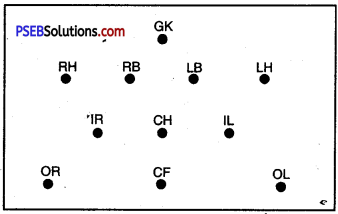
10. Push-in:
(i) When a ball passes completely across the side-line it is given a push-in or hit from the same spot. The ball is pushed in or hit by a player of the opposing team to the player who last touched it.
(ii) When push-in is being taken, no player of either team should be in the circle. If it is not so, the umpire shall ask for the second push-in.
(iii) A player who takes the push-in cannot play or touch the ball until it has been touched or played by any other player of either team.
If the rule is broken by the player who takes push-in, the push-in is awarded to the opposing team. If the rule is breached by any other player, the push-in shall be taken again. But if the rule is broken again and again, the opposing team shall be awarded a free hit.
11. Ball outside the Playfield:
(i) If the ball is sent by one of the teams over the goal-line and the goal is not scored, or if it is sent unintentionally over the goal line, from more than a distance of 25 yards from the goal line in the opinion of the umpire, by a player of the defending team, player of the defending team shall take a free hit from a distance of 16 yards of the place where the ball has crossed the goal line.
(ii) The opposing team is awarded a comer if the ball is sent out of the goal line by 25 yards intentionally by the player of the defending team.
(iii) If the defending team intentionally sends the ball over the goal line from any comer of the playfield, a penalty comer is awarded to the opposing team.
(iv) If in the opinion of the umpire, a player of the defending team sends the ball intentionally within 25 yards of the line, the opposing team is awarded a penalty comer.
12. The use of 2-Inch Iron Bangle (“Karra”):
A two inch iron bangle is used in hockey. A stick which passes through it is considered to be proper, and the player can play with that stick.
Accidents:
(a) If an umpire or a player is incapacitated by some accident the game is temporarily stopped by the umpire. The time wasted in it is recorded. If a goal is scored before the game is stopped, it shall be allowed if in the referee’s opinion it has been scored before the accident.
(b) The umpire shall re-start the game at the earliest. The play shall re-start by bully from the spot chosen by the umpire.
![]()
Question 5.
Describe some important Techniques of Hockey?
Answer:
Some Important Techniques of Hockey
So long as the players ambitions to take part in A class matches at the earliest do not acquire knowledge about important strokes of hockey, it is difficult for them to enjoy the game. I think if the newly trained players before playing in matches leam to use hockey in dribbling the ball on the ground, it will be a good beginning for them.
There is no hard and fast rule regarding the position of head, foot and hands in taking different types of strokes. But in taking an easy stroke the foot work plays an important role. First of all, a player should know how to hold the stick properly. One can leam other rules of taking strokes automatically while practising in individual and small groups. It is essential for complete success that a player should do all practice exercises at a slow pace. Then gradually he should increase his speed.
The important strokes are as follows:
Push-stroke is taken by the wrist. In this stroke the left hand is on the upper part of the handle, and the right hand remains in the middle of the stick, and the shoulders should remain directly behind it. The ball should be pushed along with the ground. This stroke is taken for small and sure ‘pass’ and it is of great creative importance.
Flick:
Both the hands remain with the stick in taking flick-stroke. This stroke is made with loose wrists. While flicking, the stick should remain totally with the ball. This stroke is taken without raising the stick behind. Normally, this stroke is made on the dribbling ball and is made, in place of a hit, for the quick exit of the ball. In the reverse flick, the reverse stick is used to move the ball to the right. It is a clever way to dodge the opponent.
When a player becomes expert in it, this type of his stroke is worth seeing. There was a time when Indian players playing with European teams used to stun them by making much use of the scoop. But recently it has been observed in a match played at New Delhi that making the best use of flick the opposing German players would succeed in throwing the ball over the Indian players, or, in other words, in entering their defence line. It was amazing that the ball was thrown inside 25 yards or more, as a result of which our defence line got no opportunity to make immediate defensive move there.
To take a powerful flick stroke it is essential that the hold on the stick is divided, that is, the hold of the right hand should remain slightly downward as compared to that of the left hand. There, is some difference in the rule to make a short distance flick stroke. Our players should be well-versed in this art because it is the best answer to the ‘player to player’ modern technique.
It is an attractive and the most useful stroke, but it needs regular practice and powerful wrists. The following exercises should be done to make the wrists more powerful:
![]()
(1) Hold the upper part of the stick with the right hand, and a little below, with the left hand. Turning the stick a little towards right push the ball. In the beginning of the stroke, the pressure of the body’s weight is on the left foot and the right shoulder turns a bit, and with it the stroke is made with the jerk of the wrist. In order to put this stroke in practice dribble the ball in the size of a circle with reverse-stroke.
(2) By remaining in that position and holding the stick only with the left hand, move the ball forward in the same manner. These two types of practice exercises are very essential, particularly for those Indian players who are totally ignorant in“left flick” or “push”. They will also provide that strength to the left hand which is essential for the flick-stroke.
This stroke is very useful from the viewpoint of giving high speed to the ball and for the quick exit of the ball. Through this stroke the player hides the direction of his ‘pass’ and also gets the essential strength for the variety of left hand.
Scoop:
This stroke is intentionally made to throw up the ball. In this stroke, the slightly bent stick remains behind the ball a little above the ground, and the two hands of the player on the stick remain far away from each other. If some problem arises in the play while making this stroke or when the ball falls on the ground, it should be deemed as infringement of rules. Though for a left – winger to dodge his opponent by throwing the ball on his stick, this stroke is very useful, yet the use of this stroke should be made occasionally. This stroke is very useful on a heavy, muddy playground.
Drive:
It is wrong notion that it is essential to raise the stick over the shoulder in any direction to hit the ball hard. The fact is that the ball reaches its destination very quickly with a hit made by the slightly backward raised stick. The speed and the strength of the hit depends upon the player’s foot work and the strength of the wrists at the time of hitting the ball. One should save oneself from the player’s undercut and the hit from below as these strokes are against the rules.
Lunge:
While making this stroke, the player holds the stick in one hand, his arms are completely drawn, the body leans over one foot and knees are bent. When the opposing player is away from the combat-distance this stroke is used to save the ball from his stick. Through this stroke the forward players can stop the ball from going out of the side line and goal line.
Jab:
This is a one-handed stroke. It can be taken either with the right or the left hand. This stroke is used to push the ball. This is a speedy forward activity of pushing the ball in which the player holds the stick in one hand and his arm remains extended forward. When two opposing players move forward with the aim of snatching the ball, use of this stroke is made to push the ball out of their reach before either of them snatches it.
For the Practice of Jab and Lunge
(a) By holding the stick in one hand and extending the arm fully, the player should do the practice of sharp jab.
(b) 1. The player should do the practice of playing reverse stroke by holding the stick in the left hand and by extending the arms fully. It will provide strength to the left wrist.
2. The two players, by placing the ball in between, should stand up. Then they should run fast to play the ball. Both the players should try to jab the ball with the right hand one before the other. Then they should try to lunge with the left hand. The practice of these two one-handed strokes is essential. When it is difficult to take the stroke with both the hands, only then the use of these strokes should be made. In other words, it.can be said that when the player needs “reach” more than the play of the game, these strokes prove to be very useful.
Dribble:
In hockey the art of dribbling is very important. A player cannot be perfect until he is not well-versed in this art. Dribbling should not be resorted to if it is adequate to hit or push the ball towards the colleague-player. The players of muddy, bouncing and uneven playgrounds should not do dribbling. The main aim of dribbling is to move the ball in possession to the left and then to the right.
The player, by maintaining this process, is to run fast. While doing dribbling a player should hold the stick in such a manner that the hold of his left hand remains upward the handle of the stick while the hold of his right hand remains 3-4 inches downward. The ball should remain one yard away from the player. While doing dribbling the stick should remain quite near the ball.
![]()
Fielding the Ball:
The experience tells that to stop the ball with the stick is very easy and quick process. That is why, hands are seldom used to stop the ball. It becomes essential to stop the ball with hands while taking the push for penalty corner or when the ball is in the air above the player’s waist in order to achieve the best result. If the ball is caught with hands, it should be immediately released.
While stopping the ball, the player should hold the stick in such a loose manner that his left hand remains on the handle of the stick and his right hand in the middle of the stick. In order to save the ball from swinging the hands should be left loose before the ball strikes. The ball is best stopped with stick.
When a rival forward player is running after the ball, then the best way to stop the ball for the player is to bring his body and stick to the level of the ball. If the player has the time and opportunity, then he should try to stop the ball from the right. Thus, he will be able to hit the ball easily.
The practice of Stopping and Hitting the Ball
Suppose two players ‘A’ and ‘B’ standing with a distance of 20 yards in between, and the centre line acts in their midst as the centre ‘R’ player hits the ball towards “A” players stops the ball and moves it back to ‘B’ again. The aim of both these players is to score the goal.
A goal is allowed if the all crosses the goal line of the rival player. In order to achieve his aim the player is to stop the ball properly and hit it back quickly. If the player has got a weak hit, then he should save himself, having entered the field of the rival player. By taking a quick hit within an area of 10 yards he will try to catch him in a difficult position.
Rules
- If the player hits the ball across the side line or the 4 yards line drawn parallel to it, then the opposing player dan take the hit anywhere from the spot of crossing the ball.
- If in the attempt to stop the ball, a player dribbles the ball over the line, then the opposing player can take the hit from the spot where the ball has dribbled.
The aim of practice is to improve the player’s art of stopping and hitting the ball. In order to make the best use of this practice, the players should remain on the look-out for the opportunity of quickly entering into and retreating from the field of the rival players.
![]()
The Practice of Stopping the Ball While Running
This practice should be done within 25 yards area towards the side line instead of the goal line. In order to catch each other in a difficult situation, both the players should hit the ball towards the left or right of the rival player. The ball going beyond reach will be stopped through lunge by the left and the right hand. The player is to learn this particular point.
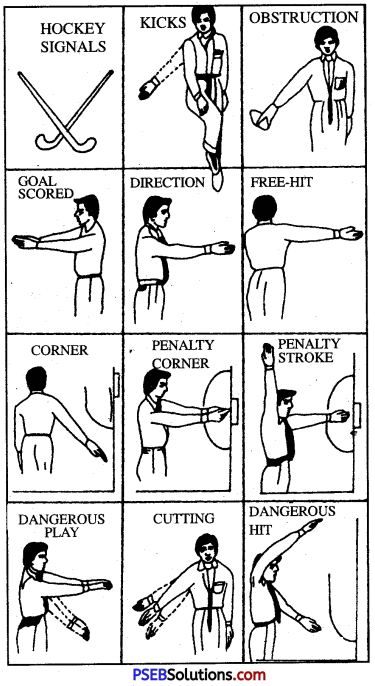
Important Information About the Hockey Game
- Numbers of players in a Hockey Team = 11 + 5
- Length of the Hockey Ground = 100 yards, 91.4 metre
- Breadth of the ground = 60 yrards, 55 metre
- Duration of the Hockey play = 35 – 35 mipjite
- Duration of interval = Five to Ten mipute
- The weight of the Hockey Ball = 5 \(\frac{1}{4}\) to 5 \(\frac{3}{4}\) Aunce
- Circumference of the ball = 224 to 235 M.M.
- Weight of the Hockey stick = 737 gms
- Size of the ring in which stick can pass through = 2.1
- The distance of each pole = 3.66 m
- The game of hockey is played between two teams. Each team has eleven players. During the play, no team can have more than one goal-keeper.
- The game has two halves of 35-35 minutes. The interval or rest will be of 5 minutes duration.
- After the interval both the teams shall change their side.
- During the play a team can substitute maximum number of players. A player once substituted can be permitted to play again.
- There are one technical official, two umpires, two judges and one reserve in a hockey match.
- No substitute shall be permitted for a suspended player.
- In the extra time the player who has been substituted can play again.
- Both the captains can change goalkeepers as per need.
- The captains can toss for the choice of ends/sides.
- No player can wear such articles as ring, ‘karha’etc.
- In the game of hockey there are in all 16 players, 11 of which take part in the game, and 5 players are kept in reserve.
- While making a stroke, the stick may not go over the shoulder.
- If the defending team intentionally commits a foul in or outside the “D”, the referee awards penalty comer.
- If the goalkeeper or any player catches the ball or press it under his foot, the referee will award penalty stroke.
- According to a new rule during the play a team can substitute maximum number of players. A player once substituted can be permitted to play again. In case of the break a player can not be substituted.
- Goalkeeper can not be changed at the time of penality comer of penelity stroke. He can be changed only while he gets hurt.
- Dotter line must be drawn of 20 yards in front of circle of 16 yards.